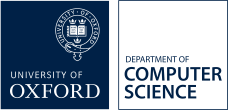How to apply
This course concentrates on creating links between theory and practice, covering a wide variety of software and hardware technologies and their applications.
The course offers the opportunity to develop more understanding of Computer Science as a subject, and focuses on the mathematical underpinnings of computer science. It offers the opportunity to gain practical problem-solving and programme design skills.
Prospectus for undergraduate entry.
Information on student experience.
1. Choose your course
The University offers
2. Choose a college
Undergraduates will belong to one of the many colleges at Oxford. More general information about colleges is available in the
As lectures are organised centrally by the department, there is very little difference in the Computer Science you will learn at the different colleges. When selecting a college you may wish to think about its size, location, costs of living, accommodation and facilities available.
When selecting a college you need to ensure that it offers the
3. Register and book the Maths Admissions Test (MAT)
More details are available on the
4. Submit a UCAS application
All applicants apply through
Applications open in May, so you can start work from then, but you will not be able to submit your application until early September.
The strict submission deadline for submitted your completed UCAS application is 6pm (UK time) on 15 October. Late applications cannot be accepted.
5. Sit the Mathematical Admissions Test
We use the MAT to help us decide who to shortlist, there is no 'pass' mark. We use the information from the test, together with all the details of your UCAS application and information about school background to decide who to shortlist.
The aim of the MAT is to test Mathematical understanding of our students rather than the breadth of knowledge. Our Computer Science students take the same test as those applying for Mathematics.
Advice on preparing for the MAT, past papers/solutions, and the test format is available on the
These
6. Interviews
Interviews happen in December via video call. Then format of the interview can vary from college to college but candidates will generally have two interviews in their first choice college and at least one interview in another college. If you are applying for a joint degree, you might have single-subject interviews for each part of the degree, or there may be an interview with tutors from both disciplines
The interview will be like a
The content of the interview will be around a Computer Science problems. There are some
A demonstration interview is below.
How to prepare
Our tutors are not mind readers, so if you don’t say anything our tutors can’t tell what you are thinking! The best practice you can do is getting used to talking about problems out loud. You may also want to try explaining concepts from your Maths qualification or the solutions to past MAT questions to friends and family. This not only gets you used to explaining your thoughts out loud, but also helps to consolidate your knowledge of the subject.
We very much don't want applicants to feel they need special training for our admissions. The main thing is that you do mathematics, lots of it, and that you find it interesting. We advise you to do lots of problems, on and near your syllabus, so that you really understand the mathematics you are learning.
7. Decisions
Decisions are communicated to shortlisted candidates in January.
More guidance on
